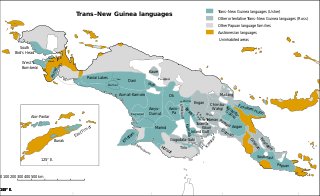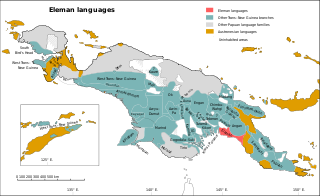
Trans–New Guinea (TNG) is an extensive family of Papuan languages spoken in New Guinea and neighboring islands, perhaps the third-largest language family in the world by number of languages. The core of the family is considered to be established, but its boundaries and overall membership are uncertain. The languages are spoken by around 3 million people. There have been three main proposals as to its internal classification.

The Papuan languages are the non-Austronesian and non-Australian languages spoken on the western Pacific island of New Guinea, and neighbouring islands, by around 4 million people. It is a strictly geographical grouping, and does not imply a genetic relationship. The concept of Papuan peoples as distinct from Austronesian-speaking Melanesians was first suggested and named by Sidney Herbert Ray in 1892.

The East Geelvink Bay or East Cenderawasih languages are a language family of a dozen Papuan languages along the eastern coast of Geelvink Bay in Indonesian Papua, which is also known as Sarera Bay or Cenderawasih.

The Trans-Fly – Bulaka RiverakaSouth-Central Papuan languages form a hypothetical family of Papuan languages. They include many of the languages west of the Fly River in southern Papua New Guinea into southern Indonesian West Papua, plus a pair of languages on the Bulaka River a hundred km further west.

The Mairasi languages, also known as Etna Bay are a small independent family of Papuan languages in the classification of Malcolm Ross, that had been part of Stephen Wurm's Trans–New Guinea proposal.
The Nimboran languages are a small independent family of Papuan languages in the classification of Malcolm Ross, that had been part of Stephen Wurm's Trans–New Guinea proposal. However, when proto-Nimboran pronouns are reconstructed (*genam "I" and kom or komot "thou"), they have little resemblance to the proto-TNG pronouns *na and *ga. Usher places them in a North Papuan stock that resembles Cowan's proposal.
The Piawi languages are a small independent family of Papuan languages in the classification of Malcolm Ross, which had been part of Stephen Wurm's Trans–New Guinea proposal.
The Senagi languages are a small independent family of Papuan languages in the classification of Malcolm Ross, that had been part of Stephen Wurm's Trans–New Guinea proposal. They consist of the two languages Angor and Dera.
Bayono, Awbono, and Densar constitute a recently discovered dialect cluster spoken in Indonesian Papua Province south of the Somahai languages. All that is known of them are a few hundred words recorded in first-contact situations. Noting insufficient evidence, Pawley and Hammarström (2018) leave it as unclassified rather than as part of Trans-New Guinea.

The Eleman languages are a family of Papua New Guinea.

The Teberan languages are a well established family of Papuan languages that Stephen Wurm (1975) grouped with the Pawaia language as a branch of the Trans–New Guinea phylum.

The Angan languages are a family of the Trans–New Guinea languages in the classification of Malcolm Ross. The Angan languages are clearly valid as a family. They were first identified as such by J. Lloyd and A. Healey in 1968; Wurm (1975) classified them as Trans–New Guinea. Glottlog treats Angan as a separate or unclassified family, pending further evidence.

The Awin–Pa or Awin–Pare languages – or, more precisely, Awin–Pa–Kamula – are a small family of the Trans–New Guinea languages (TNG)

The Mombum or Komolom languages are a pair of Trans–New Guinea languages, Koneraw and Mombum, spoken just off the southern coast of New Guinea.

The Kainantu–Goroka language are a family of Papuan languages established by Arthur Capell in 1948 under the name East Highlands. They formed the core of Stephen Wurm's 1960 East New Guinea Highlands family, and are one of the larger branches of Trans–New Guinea in the 2005 classification of Malcolm Ross.

The West Trans–New Guinea languages are a suggested linguistic linkage of Papuan languages, not well established as a group, proposed by Malcolm Ross in his 2005 classification of the Trans–New Guinea languages. Ross suspects they are an old dialect continuum, because they share numerous features that have not been traced to a single ancestor using comparative historical linguistics. The internal divisions of the languages are also unclear. William A. Foley considers the TNG identity of the Irian Highlands languages at least to be established.
The Sentani languages form a language family of coastal Indonesian Papua near the Papua New Guinea border. Sentani had been a branch of Stephen Wurm's proposal for Trans–New Guinea. The languages have lexical similarities with the Asmat–Kamoro languages, but Ross (2005) does not believe these demonstrate a genealogical relationship, and proposes instead that they are related to the East Bird's Head languages.

The Central West New Guinea languages are a group of Trans–New Guinea families in central New Guinea established by Timothy Usher, though with precedents in earlier studies.
















